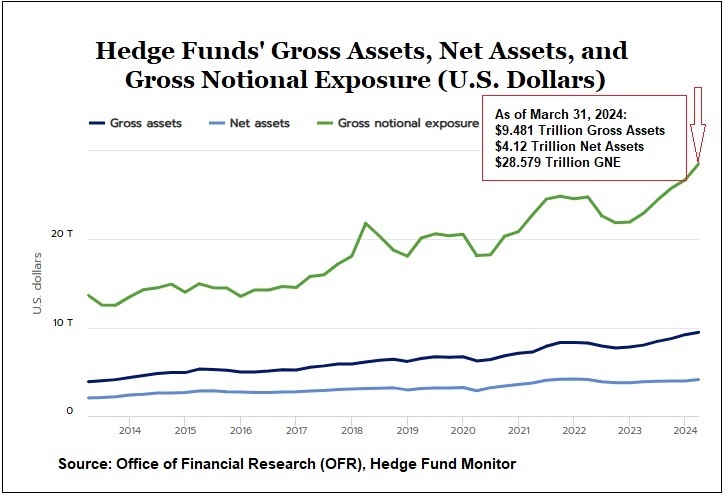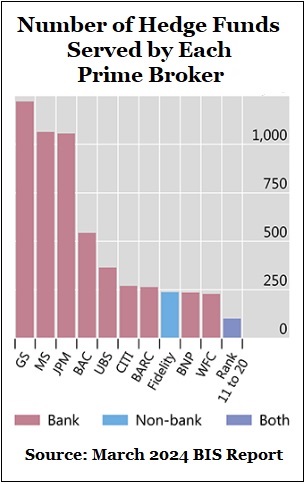Exposure at Hedge Funds Has Skyrocketed to Over $28 Trillion; Goldman Sachs, Morgan Stanley and JPMorgan Are at Risk
by Pam Martens and Russ Martens, Wall St On Parade:

According to a report at the U.S. Treasury’s Office of Financial Research (OFR), the Gross Notional Exposure at hedge funds has skyrocketed by 24.5 percent in the span of one year: from $22.946 trillion on March 31, 2023 to $28.579 trillion on March 31, 2024. (Run your cursor along the top green line at this link to observe the stunning growth in hedge fund exposures despite the banking crisis in the spring of 2023 when the second, third and fourth largest banks blew up.)
Gross Notional Exposure (GNE) is defined by OFR as “the sum of the absolute value of long and short exposures, including those on and off the balance sheet.”
TRUTH LIVES on at https://sgtreport.tv/
The OFR was created under the Dodd-Frank financial reform legislation of 2010 to keep bank and market regulators informed of growing risks, in the hope of preventing another financial crisis like that of 2007-2010 from occurring.
Unfortunately, Wall Street’s lobbying, bullying and regulatory capture has exponentially outstripped the clout of the OFR. As a result, all that the public can do is read about the potentially catastrophic risks inherent on Wall Street today at the OFR’s website and wonder when the next blowup and Fed bailout will occur. (See our report: Former New York Fed Pres Bill Dudley Calls This the First Banking Crisis Since 2008; Charts Show It’s the Third.)
The OFR carries this mild statement as to what can go wrong at over-leveraged hedge funds: “…Leveraged hedge funds are dependent on creditors’ willingness and ability to continue to lend. Further, declines in collateral and asset values can lead to margin calls that require hedge funds to tap their liquid assets….”
Allow us to fill in the gaps in that statement. The largest megabanks on Wall Street – which since the repeal of the Glass-Steagall Act in 1999 are also allowed to own taxpayer-backstopped, federally-insured, deposit-taking banks – are the major source of providing that leverage to hedge funds. This hedge fund lending and servicing operation at the megabanks is given the benign title of “Prime Broker.”
 According to a March 4 report from the Bank for International Settlements, the Prime Broker operations of Goldman Sachs (GS), Morgan Stanley (MS), and JPMorgan Chase (JPM) (all U.S. financial institutions which own federally-insured banks) were each servicing more than 1,000 hedge funds as of 2022. (See chart to the right from that report.)
According to a March 4 report from the Bank for International Settlements, the Prime Broker operations of Goldman Sachs (GS), Morgan Stanley (MS), and JPMorgan Chase (JPM) (all U.S. financial institutions which own federally-insured banks) were each servicing more than 1,000 hedge funds as of 2022. (See chart to the right from that report.)
Making this situation even more outrageous, each of these megabanks has a notorious reputation for mismanaging risk in their relationships with hedge funds in the past.
Let’s start with Morgan Stanley. During the 2008 financial crisis, Morgan Stanley owned a hedge fund called FrontPoint Partners, which was shorting subprime collateralized debt obligations (CDOs) filled with subprime residential mortgages. To be more precise, FrontPoint was hoping to profit on American homeowners being unable to pay their tricked-up mortgages and being thrown out on the street.
FrontPoint was also gleefully betting that the biggest banks on Wall Street would collapse. Michael Lewis writes in his bestselling book, The Big Short, that FrontPoint was shorting “Bank of America, along with UBS, Citigroup, Lehman Brothers, and a few others.” Lewis notes that “They weren’t allowed to short Morgan Stanley because they were owned by Morgan Stanley, but if they could have, they would have.”
And while Morgan Stanley’s own hedge fund, FrontPoint, was shorting subprime and the Wall Street banks, the Federal Reserve was infusing $16 trillion cumulatively in secret revolving loans to shore up the Wall Street banks, including $2.04 trillion in revolving loans to Morgan Stanley. (See Table 8 of the GAO report here.)
A footnote in the GAO report tells us this: “Morgan Stanley funds include TALF borrowing by funds managed by FrontPoint LLC, which was owned by Morgan Stanley at the time TALF operated.” TALF was one of the numerous emergency lending programs created by the Fed during the 2007-2010 financial crisis.
According to Fed data, FrontPoint received over $4 billion of Morgan Stanley’s $9.3 billion in TALF loans. While Morgan Stanley was the second largest recipient of total Fed emergency lending programs, it was the number one borrower under TALF with 43 percent of those funds going to FrontPoint.
Read More @ WallStOnParade.com



